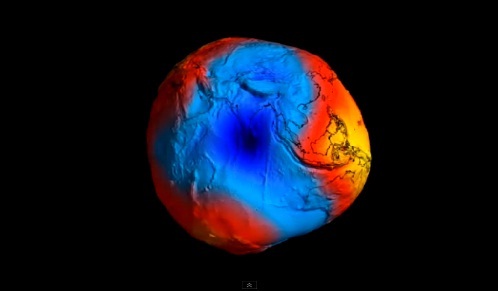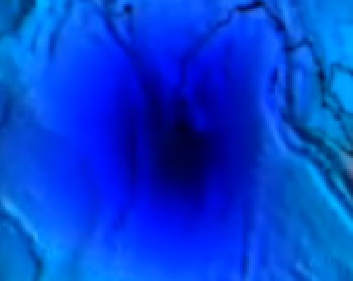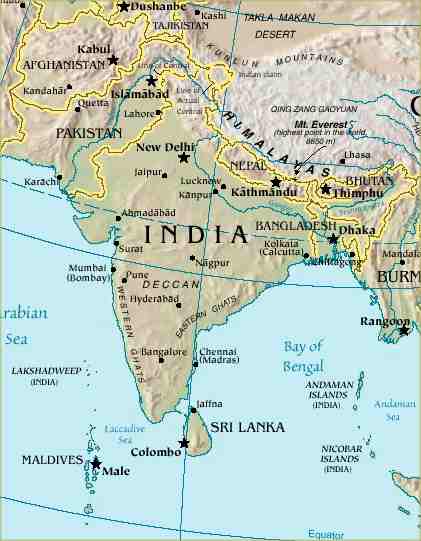It looks like you're using an Ad Blocker.
Please white-list or disable AboveTopSecret.com in your ad-blocking tool.
Thank you.
Some features of ATS will be disabled while you continue to use an ad-blocker.
share:
I was watching the ESA GOCE Earth Gravity Map and noticed the "hole" of low gravity in the general location of Sri Lanka. This gravity map has been
discussed on ATS previously, and another member did point this anomoly out, but it was towards the end of the thread and noone responded to what it
may be? Does anyone have any idea of what the cause of this could be? I know there are several theories regarding sunken cities and perhaps even
Atlantis in this vacinity, so could this be related?

A closer view:


www.sciencenews.org...
www.abovetopsecret.com...
www.abovetopsecret.com...
www.abovetopsecret.com...
www.abovetopsecret.com...

A closer view:


www.sciencenews.org...
www.abovetopsecret.com...
www.abovetopsecret.com...
www.abovetopsecret.com...
www.abovetopsecret.com...
edit on 8-1-2012 by isyeye because: (no reason given)
The Southern sea of Sri Lanka has been identified as the region with the lowest gravitational pull in the world, geologists said. According to researching scientists a particular reason behind this low gravity had not yet been discovered.
latestnewslk.blogspot.com...
Seems to be the place to be if you are fat and heavy set. Maybe a good place to launch ships into space from.
edit on 8-1-2012
by JibbyJedi because: (no reason given)
I recall that Arthur C. Clarke moved there along time ago. He wrote , among many topics, about lines from the Earth going up to a space station and a
capsule would ascend on those lines up to the space station. A particular spot with known low gravity would be a logical spot for something like that!
reply to post by Elienne
Interesting. With Indias long mysterious and advanced history, i'd say it could be anything.
Just out of curiosity, lets say that in the past there was a pole shift and that this area was once a pole. Do you think that could have anything to do with it? Wild theory i know but if you look at the opposite side of the planet from Sri-Lanka, there is another low gravity area. Although its nowhere near as low as the area in question.
Interesting. With Indias long mysterious and advanced history, i'd say it could be anything.
Just out of curiosity, lets say that in the past there was a pole shift and that this area was once a pole. Do you think that could have anything to do with it? Wild theory i know but if you look at the opposite side of the planet from Sri-Lanka, there is another low gravity area. Although its nowhere near as low as the area in question.
edit on 8-1-2012 by iksose7 because: (no reason given)
adsabs.harvard.edu...
I've read thru several articles about this low gravity anomoly. From what I can gather, the best explaination is that this happens because of the earth's Equatorial Bulge. There are other more paranormal theories that state that this area is a "spiritual portal". I have come across a few articles saying that the Vedic text originated from Sri Lanka and may be linked to this anomoly.
The Indian Ocean gravity low - Evidence for an isostatically uncompensated depression in the upper mantle
The broad gravity low in the equatorial Indian Ocean south of Sri Lanka is the largest and most striking feature in the gravitational field of the earth. The most negative long-wavelength free-air gravity anomalies are found there and the sea surface (geoid) lies more than 100 meters below the best fitting ellipsoid. A model of the lithosphere and upper mantle is proposed which accurately predicts the observed free-air gravity and geoid elevation. This model is consistent with bathymetry and sediment thickness data and suggests that the crust south of India currently floats as much as 600 meters lower than would be expected if the region were isostatically compensated. This residual depression of the crust is apparently confirmed by observations of ocean depth. An uncompensated depression is consistent with the presence of a mechanical wake left in the upper mantle behind India as it traveled toward Asia.
I've read thru several articles about this low gravity anomoly. From what I can gather, the best explaination is that this happens because of the earth's Equatorial Bulge. There are other more paranormal theories that state that this area is a "spiritual portal". I have come across a few articles saying that the Vedic text originated from Sri Lanka and may be linked to this anomoly.
edit on 8-1-2012 by isyeye because: (no reason
given)
Maybe this will help answer your question.
en.wikipedia.org...
Maybe the density of the earth's crust is alot lower there.
I see you may have found your answer as I was posting this.
Local variations in topography (such as the presence of mountains) and geology (such as the density of rocks in the vicinity) cause fluctuations in the Earth's gravitational field, known as gravitational anomalies. Some of these anomalies can be very extensive, resulting in bulges in sea level, and throwing pendulum clocks out of synchronisation. The study of these anomalies forms the basis of gravitational geophysics. The fluctuations are measured with highly sensitive gravimeters, the effect of topography and other known factors is subtracted, and from the resulting data conclusions are drawn. Such techniques are now used by prospectors to find oil and mineral deposits. Denser rocks (often containing mineral ores) cause higher than normal local gravitational fields on the Earth's surface. Less dense sedimentary rocks cause the opposite.
en.wikipedia.org...
Maybe the density of the earth's crust is alot lower there.
I see you may have found your answer as I was posting this.
edit on 8-1-2012 by kdog1982 because: (no reason given)
Truly amazing. I have never read this before.
Does anyone have any numbers associated with this anomaly? As in the deviation in percentage as related to what would be considered normal gravitational attraction elsewhere in the world? I could not find data like that, but still looking.
Does anyone have any numbers associated with this anomaly? As in the deviation in percentage as related to what would be considered normal gravitational attraction elsewhere in the world? I could not find data like that, but still looking.
reply to post by kdog1982
Thanks for that info kdog. That will lead me in a different direction to help explain this anomoly. I already found this information that may help figure this out.
www.ifs.ac.lk...
I'll look into the effects of highly crystalline, non fossiliferous rock on gravity. That could play a part in this.
Thanks for that info kdog. That will lead me in a different direction to help explain this anomoly. I already found this information that may help figure this out.
www.ifs.ac.lk...
Nine tenths of Sri Lanka is made up of highly crystalline, non fossiliferous rocks
I'll look into the effects of highly crystalline, non fossiliferous rock on gravity. That could play a part in this.
reply to post by charlyv
This anomaly, and a couple others of its kind, represent a -0.0153% deviation from Standard Gravity. Hardly impressive, but definitely significant.
This anomaly, and a couple others of its kind, represent a -0.0153% deviation from Standard Gravity. Hardly impressive, but definitely significant.
Originally posted by CLPrime
reply to post by charlyv
This anomaly, and a couple others of its kind, represent a -0.0153% deviation from Standard Gravity. Hardly impressive, but definitely significant.
I was wondering what the difference is between the highest gravitational acceleration and the lowest is.
That is,what difference ,however small,would it be.
Could I jump high enough for a slam dunk in basket ball.
reply to post by kdog1982
The only non-negligible difference in Earth's surface gravity is that between the poles (9.832 m/s^2) and the equator (9.780 m/s^2). A 180-lb person at the equator will weigh 181 lbs at the poles. I'm not sure how that would help with your slam dunk.
The only non-negligible difference in Earth's surface gravity is that between the poles (9.832 m/s^2) and the equator (9.780 m/s^2). A 180-lb person at the equator will weigh 181 lbs at the poles. I'm not sure how that would help with your slam dunk.
I wonder if the newly discovered anti matter that is trapped in Earths orbit have anything to do with it. There is something called the south atlantic
anomaly and this area also has gravity anomalies.
But looking at the image It looks like something big had gone in one side and tried to punch its way through the other.
But looking at the image It looks like something big had gone in one side and tried to punch its way through the other.
Originally posted by CLPrime
reply to post by kdog1982
The only non-negligible difference in Earth's surface gravity is that between the poles (9.832 m/s^2) and the equator (9.780 m/s^2). A 180-lb person at the equator will weigh 181 lbs at the poles. I'm not sure how that would help with your slam dunk.
They also factor in the rotation of the earth.
More force trying to throw you off the planet at the equator,less at the poles.
Then you factor in the different gravitational "pull" at various points on the planet.
Just putting it in laymen terms.
The slam dunk is just wishful thinking on my part as a short guy,every little bit helps.
Originally posted by CLPrime
reply to post by charlyv
This anomaly, and a couple others of its kind, represent a -0.0153% deviation from Standard Gravity. Hardly impressive, but definitely significant.
Thank you for that. Numbers mean everything. Although not as significant as I was believing, given the graphic, the granularity of the data being heavily weighted, it is an anomaly not easily explained and I really wonder what the true cause of it may be. It is amazing what we do not yet understand about this planet, and I will bet the truth of this whole situation may become a very important topic once science can get a handle on it.
reply to post by kdog1982
Thinking of the Earth's rotation... the centripetal force at the equator actually contributes to a greater gravity anomaly than this site in the Indian Ocean. -0.3468% versus -0.0153%.
Thinking of the Earth's rotation... the centripetal force at the equator actually contributes to a greater gravity anomaly than this site in the Indian Ocean. -0.3468% versus -0.0153%.
reply to post by isyeye
I don't know why it is there, but I wonder why we don't utilize it? Why don't all spacecraft take off from Sri Lanka? Even a minimal gravitational reduction could save thousands of pounds of rocket fuel!
I don't know why it is there, but I wonder why we don't utilize it? Why don't all spacecraft take off from Sri Lanka? Even a minimal gravitational reduction could save thousands of pounds of rocket fuel!
Originally posted by getreadyalready
reply to post by isyeye
I don't know why it is there, but I wonder why we don't utilize it? Why don't all spacecraft take off from Sri Lanka? Even a minimal gravitational reduction could save thousands of pounds of rocket fuel!
You are absolutely right. If Sri Lanka was smart, they could exploit this anomoly for some big $$$$$$.
If they had a proper marketing campaign to bring in private companies interested in space exploration, or even foriegn governments, this could be a huge source of money for them.
reply to post by isyeye
They would hardly have to exploit the anomaly. It wouldn't hurt, but being very near the equator would be a much greater benefit. If they were going to establish a launch site, the equator part would have been the deciding factor long before this anomaly was discovered. That would be like a kid passing up on candy just to then accept the candy because someone adds an extra grain of sugar to it.
They would hardly have to exploit the anomaly. It wouldn't hurt, but being very near the equator would be a much greater benefit. If they were going to establish a launch site, the equator part would have been the deciding factor long before this anomaly was discovered. That would be like a kid passing up on candy just to then accept the candy because someone adds an extra grain of sugar to it.
reply to post by CLPrime
So................ sounds like a start-up endeavor!! Some pretty simple math would turn into some pretty simple marketing, and a huge windfall for Sri Lanka and the guys that market it on their behalf! Plus, I hear Sri Lanka is beautiful! I wouldn't mind moving there and becoming their minister of Space Marketing.
So................ sounds like a start-up endeavor!! Some pretty simple math would turn into some pretty simple marketing, and a huge windfall for Sri Lanka and the guys that market it on their behalf! Plus, I hear Sri Lanka is beautiful! I wouldn't mind moving there and becoming their minister of Space Marketing.
Originally posted by minor007
I wonder if the newly discovered anti matter that is trapped in Earths orbit have anything to do with it. There is something called the south atlantic anomaly and this area also has gravity anomalies.
But looking at the image It looks like something big had gone in one side and tried to punch its way through the other.
Well,could have been how the moon was created.
The giant impact hypothesis is the currently favoured scientific hypothesis for the formation of the Moon.[3] Supporting evidence includes the same direction of motion of the Earth's spin and the Moon's orbit,[4] Moon samples which indicate the surface of the Moon was once molten, the Moon's relatively small iron core and lower density than the Earth, and evidence of similar collisions in other star systems (which result in debris disks). Further, giant collisions are consistent with the leading computer models of the formation of the solar system.
en.wikipedia.org...
new topics
-
The hunter has become the hunted
Mainstream News: 2 hours ago -
Trump's idea to make Canada the 51st US state: 'Potential is massive'
Mainstream News: 2 hours ago -
Well this is Awkward .....
Mainstream News: 7 hours ago -
Kurakhove officially falls. Russia takes control of major logistics hub city in the southeast.
World War Three: 8 hours ago
top topics
-
Well this is Awkward .....
Mainstream News: 7 hours ago, 17 flags -
The hunter has become the hunted
Mainstream News: 2 hours ago, 14 flags -
Liberal Madness and the Constitution of the United States
US Political Madness: 14 hours ago, 10 flags -
Kurakhove officially falls. Russia takes control of major logistics hub city in the southeast.
World War Three: 8 hours ago, 9 flags -
Trump's idea to make Canada the 51st US state: 'Potential is massive'
Mainstream News: 2 hours ago, 8 flags
active topics
-
Trump's idea to make Canada the 51st US state: 'Potential is massive'
Mainstream News • 16 • : Freeborn -
New York Governor signs Climate Law that Fines Fossil Fuel Companies
US Political Madness • 29 • : NeedInfo -
Well this is Awkward .....
Mainstream News • 26 • : NeedInfo -
The hunter has become the hunted
Mainstream News • 11 • : hangedman13 -
Liberal Madness and the Constitution of the United States
US Political Madness • 13 • : charlest2 -
This is why ALL illegals who live in the US must go
Social Issues and Civil Unrest • 33 • : GENERAL EYES -
Elon Musk futurist?
Dreams & Predictions • 20 • : GENERAL EYES -
Plane Crash Today --Azerbaijanian E190 passenger jet
Mainstream News • 47 • : GENERAL EYES -
London Christmas Market BANS Word ‘Christmas’
Social Issues and Civil Unrest • 56 • : Connector -
Trump says ownership of Greenland 'is an absolute necessity'
Other Current Events • 62 • : GENERAL EYES
